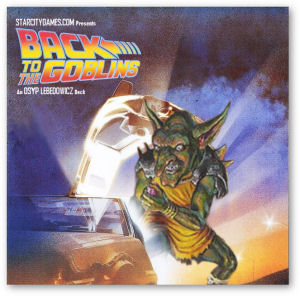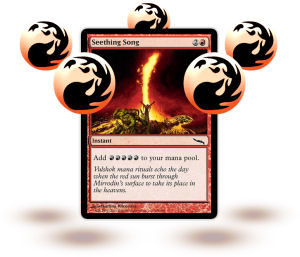“I will never play Goblins again; I actually signed a contract stating that very fact.” — Josh Ravitz
The Extended season is in full swing and it seems to be a very healthy format. There are a wide variety of decks and Ravnica seems to be making a healthy contribution. The Dredge mechanic is proving to be quite powerful and the new dual lands are allowing deck builders to be more creative than ever. Going into PT LA, I didn’t think that Ravnica would have as huge an impact on the format as it has had. I thought the new dual lands were awesome and would see a lot of play, but other than those I didn’t think any of the new cards, or the new mechanics for that matter, would really change the environment. So with a new set that provided access to cards like Life from the Loam, Watery Grave, Sacred Foundry and Dark Confidant, what did I choose to play? A mono Red Goblin deck circa 1985.

Let me explain exactly how I ended up playing Goblins.
Our testing gauntlet had most of the decks that appeared at PT LA – the only thing we really missed was the Life from the Loam engine in Psychatog. We did end up gaining that information prior to the PT, but it was still losing to our Affinity deck. Our Affinity deck was beating all of the control decks so handily that they started to just slip out of our gauntlet completely. What we ended up with was an Affinity deck that destroyed control, but would get crushed by any aggressive deck. Heartbeat was probably our second most popular deck, and it was the same list Star Wars Kid ended up making the Top 4 with. I simply did not like any of those decks.
One deck that I started testing late in the game was Goblins. At first, I thought the loss of Aether Vial would make Goblins too slow. I was never a fan of Goblins in any of the previous formats, so testing Goblins seemed pointless to me. However, once I started getting a better idea of what our gauntlet looked like, it seemed like Goblins could actually be decent in this environment. I started testing various lists – some splashed White for sideboard cards, some splashed Black for Cabal Therapy and Patriarch’s Bidding. At one point, I even had a three color Goblin deck that splashed for Gifts Ungiven and the Black package. Casting a Gifts for Sins from the Past, Patriarch’s Bidding, Burning Wish and Goblin Warchief was cute, and Watery Grave made it much more reasonable on the mana base, but in the end it never went anywhere. Finally Antonio DeRosa mentioned something about a mono Red Goblin deck that just ran Seething Song and was very aggressive. I have liked the idea of Seething Song in a Goblin deck ever since I saw some of them in action last year at Worlds, so I put together a list and started testing.
The first thing I noticed was that your matchup against Affinity was very good. Game one they had few answers to cards like Sharpshooter and Sparksmith, and the only way they actually could beat you involved Acrbound Ravager and evasion creatures. I also liked how the Heartbeat matchup went. Both decks were very fast, so whoever played first usually won. However, the Goblin deck stumbled much less than Heartbeat did, so the matchup still seemed to favor Goblins slightly. Goblins was also doing quite well against all of the random creature decks that we were testing. The random three color aggressive decks that we were trying just couldn’t keep up with Goblins’ utility, and Rock decks would get overwhelmed by Goblin Ringleader.
Basically, without Psychatog playing a big role in our gauntlet, it seemed like Goblins was actually a solid choice for the PT. One concern that many of my teammates had however was how many Engineered Plagues would be running around. Last year I decided not to run Affinity because I was afraid of the number of Energy Flux that would be in the field; I didn’t want to make the same mistake this year. I started to test post sideboard games and see how the deck actually faired against the Plague. The first thing I noticed was that deck was actually pretty resilient to one Engineered Plague, since your primary Goblins could all survive one Plague. Two Plagues obviously was a beating no matter what, and there was very little I could do. I thought about using dragons like Rorix and Hunted Dragon, but it just didn’t seem worth it. One card that was awesome was Goblin King. A King still wouldn’t help you against two Engineered Plagues, but two Kings did make an impact. The main reason I like Goblin King so much though was that it helped increase the number of powerful draws the deck could get. I also was planning on sideboarding into Blood Moon, which made the mountainwalk effect the King provided an added incentive.
The Goblin decks I saw at Worlds last year that ran Seething Song also ran Arc-Slogger in the sideboard. I thought the idea of a quick Arc-Slogger was pretty awesome against any aggressive deck, and it should also provide you with an excellent win condition against Affinity if they get double Plague going.
This is the list that I went into the Pro Tour with.
4 Skirk Prospector
2 Goblin Sledder
4 Goblin Piledriver
4 Goblin Matron
4 Goblin Warchief
4 Gempalm Incinerator
3 Goblin Sharpshooter
4 Goblin Ringleader
2 Siege-Gang Commander
2 Goblin King
2 Goblin Burrows
18 Mountains
Sideboard:
4 Blood Moon
3 Sword of Fire and Ice
3 Pithing Needle
2 Flaring Pain
2 Overload
1 Goblin King
I was happy with the list, but I ended up getting talked out of playing the Sloggers. I really wanted to run them, but for some reason I listened to Billy Pumplestinkle and ended up playing Sword of Fire and Ice instead. I really wish I had the Arc-Slogger.
Three of us played this list at the PT, and I was the only one who made Day 2, the others lost in the last round to finish at 4-4. I was in Top 8 contention up until round 14. With only four losses, there was a chance I could make Top 8 if I won my last two rounds. Sadly, I lost in round 15 to Raphael Levy and his double Engineered Plagues in game 3. In the final round, I lost to Dave Williams and his double Armadillo Cloaked Kird Ape. Not the best way to finish up a tournament, but at least I made Top 48.
Despite the fact that it didn’t put up the best numbers, I was still very happy with my choice. Most of the games I won were blow outs, and the ones I lost were all very close (except for the last round against Dave). I really think that if more players had Seething Song in their Goblin lists, that the archetype would’ve done better on average. The Seething Song helped fuel some really absurd draws and allowed me to win games on turn 4 several times throughout the tournament.

I played against a wide variety of decks and I felt like I didn’t have any really bad matchups. I played against Alexander Peset, who was playing the same Psychatog deck Antoine Ruel used to win the PT. I lost the match but our games were very close. In game one I crushed him, but in the post sideboarded games I simply couldn’t handle Razormane Masticore. I didn’t even board in the Overload for game two because I didn’t expect it, and in game three I could’ve won had I topdecked an Overload at any point in the game. All of this makes me think the matchup isn’t too bad. I played against Geoffrey Siron and his Mongrel/Psychatog deck and I crushed him pretty easily. There are many different variations of this archetype, so the matchup really depends on what their list is. Basically, if they are running the list that is purely aggressive and runs little or no counters, then the matchup is actually pretty good for Goblins. If they don’t get a Psychatog into play by turn 4 then you can usually smash right through. The heavier permission based Tog decks can give you more trouble, but it’s still not that bad. The good news is that you will almost never have to deal with Engineered Plague after sideboard from any of the Tog decks, so the post sideboard games are much easier for you because of Pithing Needle.
After my PT experience and seeing how the metagame is shaping up now, I would alter the deck for the PTQ’s slightly.
Post LA List:
Creatures (32)
- 4 Goblin Matron
- 2 Goblin King
- 4 Goblin Warchief
- 2 Goblin Sharpshooter
- 4 Goblin Piledriver
- 4 Gempalm Incinerator
- 2 Siege-Gang Commander
- 4 Goblin Ringleader
- 4 Skirk Prospector
- 2 Goblin Sledder
Lands (2)
Spells (26)
Sideboard

Goblins has really gone out of style lately, it’s just not as popular in Extended as it once was. This means that the likelihood of running into Engineered Plague now is even less. I strongly recommend that you test this deck out if you like Goblins, played them in the past, or thought about playing Goblins but just didn’t think they could hold up in this environment. The deck is very consistent and will do very well against creature-based decks. Affinity and Boros Deck Wins are both good matchups and get better after sideboard. Heartbeat is a even matchup, but it only gets better for you after game 1 thanks to Flaring Pain out of the board. The main deck you have to be concerned with is Tog. Like I said, if they’re playing Madness Tog then the matchup is very good for you. However, if they are running a more controllish Tog variant, it becomes a bit of a battle.
When sideboarding, you generally want to board out the Gempalms and the Sharpshooters and Sledders against control decks and usually board in some number of Pithing Needles, Overloads and Goblin Kings. Against Boros Deck Wins you want to board out the Sharpshooters, Goblin Kings, and three Piledrivers for the Overloads and Arc-Sloggers. Against Affinity you’re boarding in 11 cards and taking out the Piledrivers, Ringleaders, Kings and one Siege-Gang. Now I know taking out Ringleader seems crazy to some people, but he’s really not integral in beating the Affinity deck, and you’re boarding in a lot of non-goblins so he actually hits much less often because of that.
I think that the deck is a lot better than people give it credit for and can really take a PTQ by surprise. Test it out and see for yourself.
Good Luck
Osyp “Joe Black” Lebedowicz
